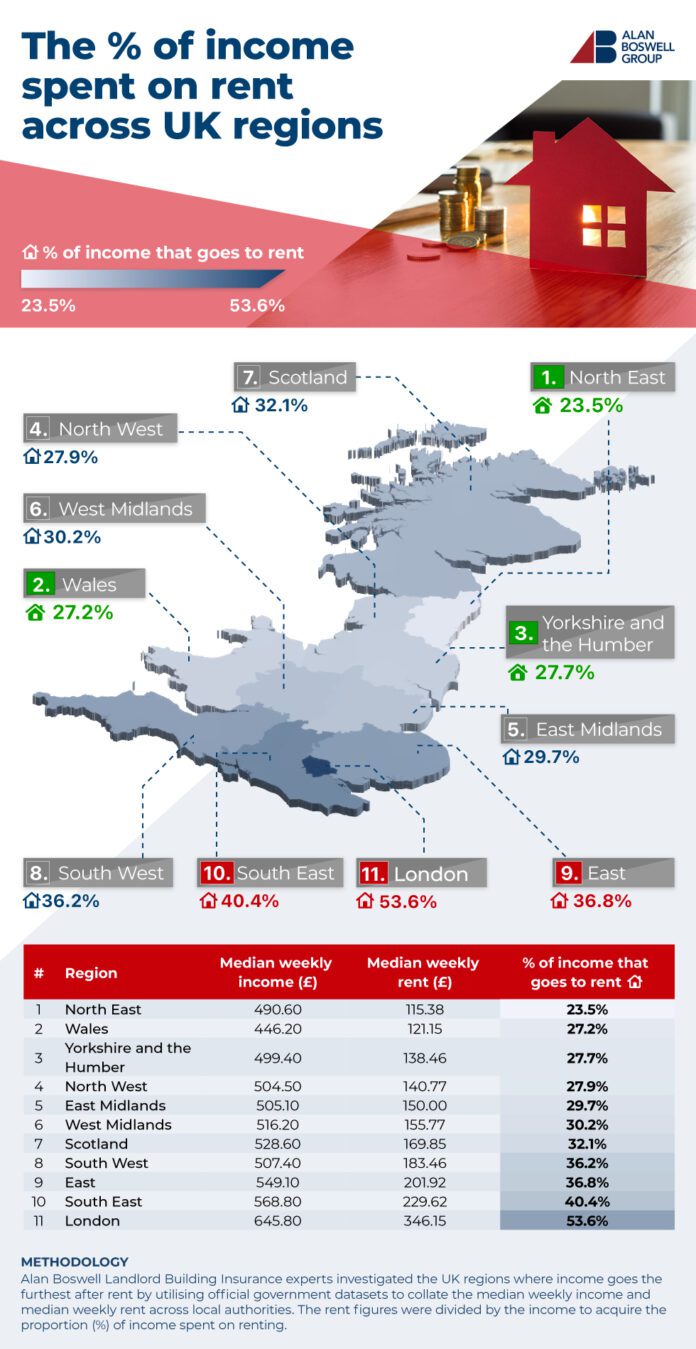As the cost of living crisis surges, renters are facing the possibility of increased rental costs. But with rent costs differing considerably across the UK,which areas arethe most affordable for renters?
In light of this, Alan Boswell Landlord Building Insurance experts used official government statistics* to investigate which UK regions are spending the least on rent by calculating the proportion (%) of income spent on rent across regions.
This is part of a wider study, which can be found at: https://www.alanboswell.com/news/the-average-cost-of-renting-a-house-in-the-uk/
Key findings:
- Welsh residents are spending the least on rent (27.2%) across the UK, England spending the most (34.1%)
- Merthyr Tydfil residents are spending 22.26% of their income on rent – the lowest in Wales
- Followed by Blaenau Gwent renters (22.53%)
- Cardiff residents are spending the most (33.86%)
Welsh areas spending the least on rent:
| Rank | Local authority | Median weekly income (£) | Median weekly rent (£) | % of income that goes to rent |
| 1 | Merthyr Tydfil | 440.60 | 98.08 | 22.26% |
| 2 | Blaenau Gwent | 384.10 | 86.54 | 22.53% |
| 3 | Neath Port Talbot | 459.40 | 103.85 | 22.60% |
| 4 | Powys | 430.50 | 98.08 | 22.78% |
| 5 | Carmarthenshire | 451.20 | 107.31 | 23.78% |
| 6 | Rhondda Cynon Taf | 430.10 | 103.85 | 24.14% |
| 7 | Torfaen | 455.40 | 114.23 | 25.08% |
| 8 | Wrexham | 480.70 | 121.15 | 25.20% |
| 9 | Bridgend | 449.40 | 115.38 | 25.68% |
| 10 | Caerphilly | 444.90 | 114.23 | 25.68% |
Please find the full data breakdown of all regions and Wales’ local authorities analysed within this data sheet.
Alan Boswell Landlord Building Insurance experts can reveal that amongWales’ localities, renters in Merthyr Tydfil are spending the lowest proportion of their weekly income on rent (22.26%).
Followed by Blaenau Gwent, where residents are spending an average of 22.53% of their wage on rent.
Neath Port Talbot comes in third where a proportion of 22.6% of local renters’ income are spent on their rent.
Welsh areas spending the most on rent:
| Rank | Local authority | Median weekly income (£) | Median weekly rent (£) | % of income that goes to rent |
| 1 | Cardiff | 477.10 | 161.54 | 33.86% |
| 2 | Conwy | 406.60 | 126.92 | 31.22% |
| 3 | Denbighshire | 404.10 | 121.15 | 29.98% |
| 4 | Vale of Glamorgan | 485.50 | 144.23 | 29.71% |
| 5 | Ceredigion | 409.30 | 121.15 | 29.60% |
| 6 | Flintshire | 449.50 | 129.23 | 28.75% |
| 7 | Swansea | 440.30 | 125.77 | 28.56% |
| 8 | Gwynedd | 401.40 | 112.50 | 28.03% |
| 9 | Monmouthshire | 504.50 | 137.31 | 27.22% |
| 10 | Pembrokeshire | 419.90 | 111.92 | 26.65% |
On the other hand, those renting in Cardiff, are spending over 33.86% of their salary on rent on average – the most among Wales’ localities analysed.
Conwy follows next, where 31.22% of its resident’s average income goes towards rent.
The % of income spent on rent across UK regions:
| Rank | Region | Median weekly income (£) | Median weekly rent (£) | % of income that goes to rent |
| 1 | North East | 490.60 | 115.38 | 23.5% |
| 2 | Wales | 446.20 | 121.15 | 27.2% |
| 3 | Yorkshire and the Humber | 499.40 | 138.46 | 27.7% |
| 4 | North West | 504.50 | 140.77 | 27.9% |
| 5 | East Midlands | 505.10 | 150.00 | 29.7% |
| 6 | West Midlands | 516.20 | 155.77 | 30.2% |
| 7 | Scotland | 528.60 | 169.85 | 32.1% |
| 8 | South West | 507.40 | 183.46 | 36.2% |
| 9 | East | 549.10 | 201.92 | 36.8% |
| 10 | South East | 568.80 | 229.62 | 40.4% |
| 11 | London | 645.80 | 346.15 | 53.6% |
Please find the full data breakdown of all regions analysed within this data sheet, alongside a graphic here.
Residents from the North East are spending the leastof their wages on rent, amounting to only 23.5%. This is 8.6% less than its neighbouring Scottish residents (32.1%) and 4% less than the North West at 27.9%.
Wales places second best, with 27.2% of resident’s income being spent on rent. Whilst its bordering region, theWest Midlands, are spending more (30.2%).
Whilst the renting crisis is UK-wide, Londonresidents are spending the largest proportion of their weekly income on rent at a startling 53.6% – exceeding more than half of their wage on average.
Heath Alexander-Bew, director of personal lines at Alan Boswell Landlord Building Insurance experts, provided a few tips to help ease the rising cost of living:
- Apply a money-saving method that fits your situation – Through shows like ‘The Martin Lewis Money Show‘, viewers can learn useful money-saving methods like topping up and maxing out on energy meters before March 31st, ahead of the April price hike (if you are responsible for these, to help reduce the cost of your energy bill until you need to top up again). If you are struggling to pay, you can also speak to your energy firm who may offer hardship funds for existing customers.
- Check if you qualify for a tax-credit claim – For those with lower income, you may be eligible to apply for a working tax-credit (Universal Credit), which enables you to receive extra cash to help with daily expenses. The government’s cost of living support page provides more advice on your specific needs, including the tax-credit claims and housing cost support.
- Other cost of living services are readily available for the public such as food banks to help individuals and families alike struggling with the current cost of living.
Credit to https://www.alanboswell.com/landlord-insurance/landlord-building-insurance/ who commissioned the study and provided the above article.
Help keep news FREE for our readers
Supporting your local community newspaper/online news outlet is crucial now more than ever. If you believe in independent journalism, then consider making a valuable contribution by making a one-time or monthly donation. We operate in rural areas where providing unbiased news can be challenging. Read More About Supporting The West Wales Chronicle
























